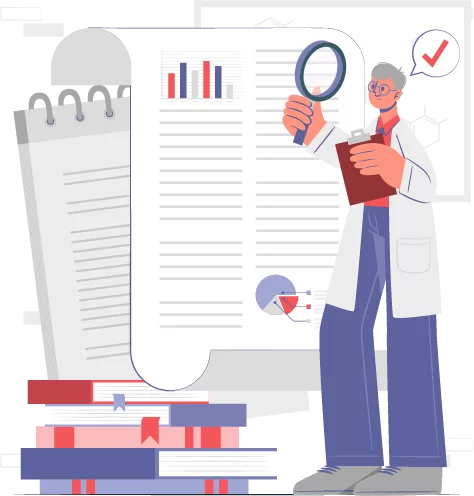Starting a research project begins with one essential task: writing a research proposal. A research proposal gives you the opportunity to present your study idea, outline your plan, and explain why it is important. Your proposal can make or break the outcome, whether you are applying for a university degree, trying to get approval for a thesis, or submitting a grant request.
Key Takeaways:
- A research proposal clearly presents your research idea, objectives, methods, and significance to secure approval, support, or academic recognition.
- Every section in the proposal must follow a structured format, demonstrate relevance, and align with academic or institutional expectations.
- Strong proposals reflect original thinking, a clear research intent, a suitable methodology, and the potential to contribute knowledge or address a specific research problem.
Why Writing a Research Proposal Matters?
Writing a strong research proposal is not just a formality. It demonstrates your ability to think clearly, plan effectively, and make a meaningful contribution in your field. It is a critical part of gaining approval, funding, or academic support.
In short, the proposal is your foundation. Get it right, and it sets the direction for everything that follows.

Purpose of a Research Proposal
The purpose of the research proposal is to clarify the aims of the research study before it begins. It guarantees that you convey your research intent in a clear and structured manner. A research proposal is an opportunity to show that you have thought through your research idea, identified the problems and have a proper plan to investigate it.
A strong proposal must have a topic that is both relevant and original, and follow a research path that provides a fresh angle on an existing issue or offers insight into an unexplored area. Meeting these academic or professional standards shows that you are serious, prepared, and aware of the environment you’re working in.
In short, the proposal is your foundation. Get it right, and it sets the direction for everything that follows.
How to Structure a Research Proposal?
A good research proposal is not just an interesting research idea, but also how you draft and present your research idea in a logical and convincing way. Each part of the proposal serves a specific purpose, and knowing what to include makes the writing process smoother and more efficient.
Let’s walk through each of the key components.
Title
The title is the first thing the reader notices in your proposal. It must encapsulate the essence of your research in a precise and concise way. Choosing a strong title makes it unique while avoiding generality. It must be aligned with the research and address identifiable gaps. The best title is relevant to the research and sparks the reader’s interest.
While choosing a topic for your research study, you must:
Tip: Keep it specific and clear.
Abstract
Abstract comes right before the introduction, but the best way to write a perfect abstract is to write it last. It is a concise section that articulates the central research problem while defining the study’s objectives, methodology, and expected outcomes. A well-crafted abstract is a summary that helps the reader grasp the proposal’s value at a glance.
A well-structured abstract includes:
Tip: Keep it between 150–250 words, and make sure it reflects all key elements of your proposal.
Introduction
The introduction is where you will explain the context of your research focus and build a strong foundation. The introduction lays the groundwork for your research by presenting the topic, contextualising the problem, and articulating the purpose of the study. It demonstrates a clear understanding of existing literature while outlining how your study will contribute new insights. This section also sets expectations regarding the research plan, scope, and potential limitations.
It should include:
Literature Review
A literature review is an essential part of drafting a research proposal. It includes an analysis of existing research to identify what is unexplored. To write this section, it is important to use credible resources such as peer-reviewed journals, academic books and reputable data sources.
You must be introducing your theoretical framework, connecting existing theories to your research objectives and highlighting where further exploration is needed. Additionally, present your conceptual framework by identifying key variables, themes, or factors in the literature that are likely to affect your research outcomes.
Presenting the literature thematically or methodologically, rather than chronologically, often leads to a more compelling narrative. This section shows your critical thinking and justifies your research by connecting it to what’s already out there.
Tip: Organise your review by theme or method, not just by date.
Research Methodology
Research methodology includes all the processes that you are planning to use to address the problem you are researching. It must begin with specifying whether your research will employ qualitative, quantitative, or mixed methods. Then, provide a detailed explanation of the research design, such as case studies, surveys, ethnography, content analysis, experiments, or another method.
Justify your choices by explaining why they are suitable for your research objectives. Furthermore, this section must include ethical considerations, such as informed consent, anonymity, and data protection, particularly if human participants are involved. The methodology should be detailed enough to allow for replication or close scrutiny.
Include the following:
Tip: Make your methodology realistic and detailed—clearly explain what you will do, how, and why, ensuring your approach fits your aims, timeline, and available resources.
Timeline
This section provides an estimated timeframe for completing each section of the research proposal. This way, it would be helpful for both you and the reviewer of your research proposal to have an idea whether the project is feasible within the available time period. This plan must cover all the stages of the research process from preliminary to final reporting.
You can create a visual representation of the project timeline using a Gantt Chart, which clearly maps each activity against its guidelines. A well-thought-out timeline not only communicates your preparedness but also builds trust in your ability to deliver results within a structured timeframe.
Tip: Make sure your plan aligns with submission deadlines
TExpected Outcomes/ Significance
In the research proposal, this section describes the potential contribution of your research project. As the results cannot be predicted with certainty, this section will explain the type of findings you are hoping to get. Discuss the research problems you are addressing and how it could open doors for future investigations.
Expected outcomes must include:
Tip: Be clear about the expected contribution—state how your research could solve a problem or guide future studies.
Ready to strengthen your research skills?
OTHM Level 7 Certificate in Research
Methods is the step you need to take
Enrol Now!
References
A research proposal is not complete without a comprehensive list of all sources you have cited in your document. This reinforces the academic integrity of your work and allows readers to verify or further explore referenced materials. You must use a consistent and appropriate citation style throughout the document, such as APA, Harvard, or MLA, depending on the disciplinary requirements.
Tip: Only include sources that are directly cited in your proposal. Irrelevant or excessive references can distract from your argument and reduce clarity.
Appendices
The appendices include supporting materials that are relevant to your research proposal but too detailed to be placed in the main sections. This may include instruments such as questionnaires, interview guides, observation checklists, or any other data collection tools mentioned in your methodology.
Tip: Label each appendix clearly and refer to it in the main proposal when needed.
Conclusion?
Writing a research proposal is the first step to turning your research idea into a structured study. From choosing the right title to clearly outlining your methods and expected outcomes, every section plays an important role. A strong proposal shows that your topic is relevant, your plan is clear, and your study is worth doing. By following each step in this blog, you can create a well-organised proposal that communicates your ideas effectively and meets academic standards. Keep it clear, focused, and purposeful; your proposal sets the stage for everything that follows.
Course Categories

OTHM Level 7 Diploma in
Accounting and Finance (RQF)
£990 £690 Limited Time Offer.
Monthly instalment plans available.
Awarding body fee of £300 payable
by learner within 14 days.

OTHM Level 6 Diploma in
Accounting and Business (RQF)
£990. Monthly instalment plans available.
£300 awarding body fee due within 14 days.

OTHM Level 5 Diploma in
Accounting and Business (RQF)
£990. Monthly instalment plans available.
£250 awarding body fee due within 14 days.



